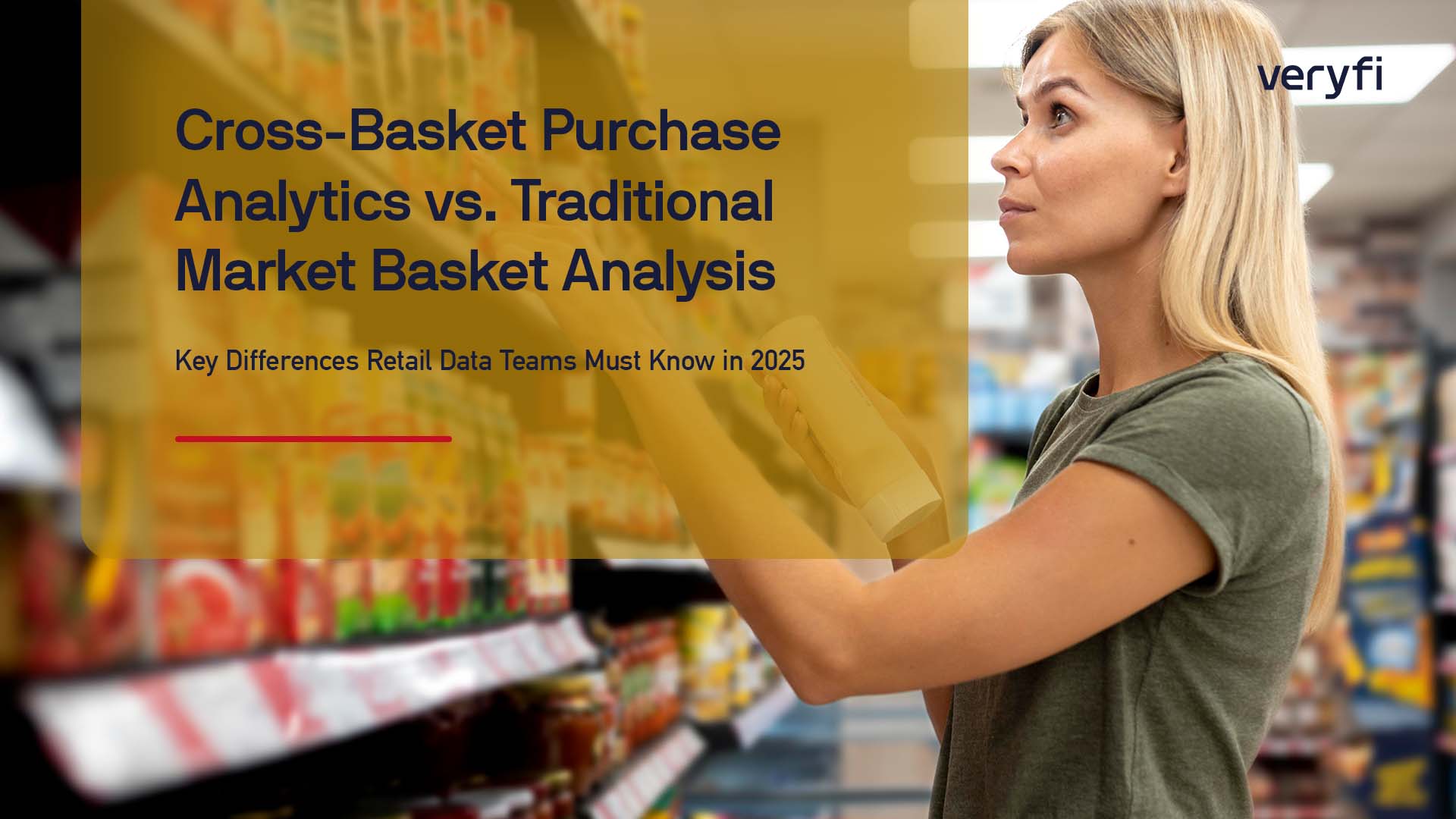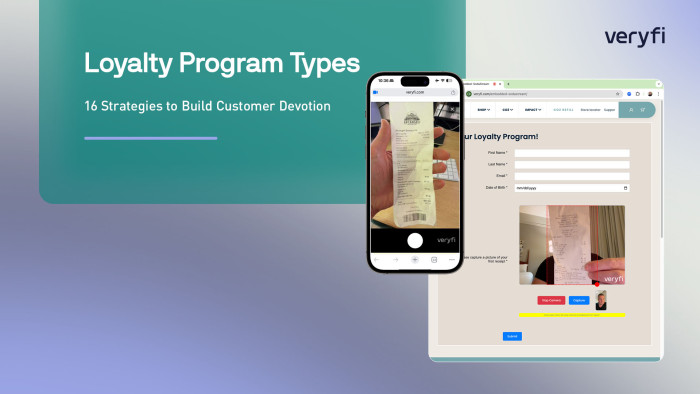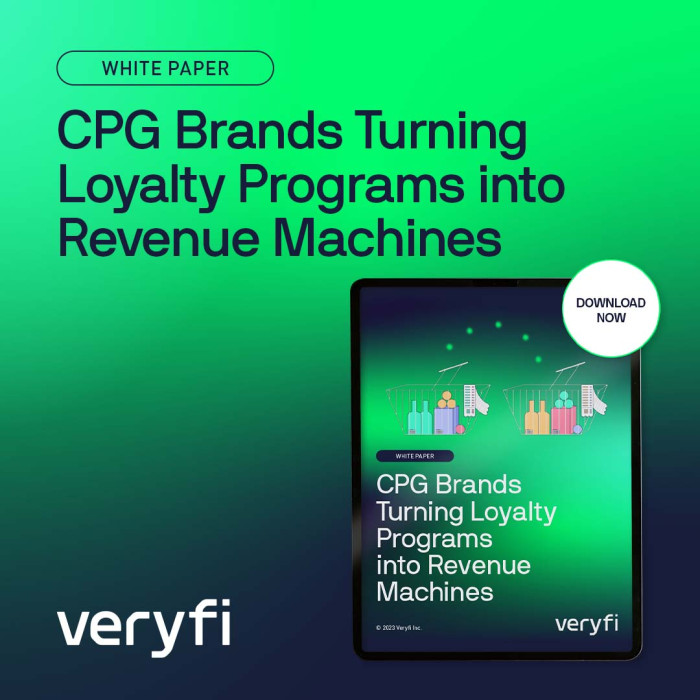Introduction
Retail data teams often use “market basket analysis” and “cross-basket purchase analytics” interchangeably, but these methodologies serve fundamentally different purposes in 2025’s data-driven retail landscape. Traditional market basket analysis (MBA) examines what customers buy together in a single transaction, while cross-basket analytics extends this concept across multiple purchases, categories, channels, and time windows. (Veryfi CPG Toolkit)
The distinction matters more than ever as consumer packaged goods (CPG) brands and retailers seek deeper insights into customer behavior patterns. (Veryfi CPG Toolkit) While MBA might reveal that customers who buy chips also purchase soda in the same transaction, cross-basket analytics uncovers that customers who buy organic baby food in January are 40% more likely to purchase premium skincare products three months later.
This evolution from single-transaction analysis to multi-dimensional customer journey mapping requires fundamentally different data infrastructure, analytical approaches, and technological capabilities. (Veryfi Product Matching)
Understanding Traditional Market Basket Analysis
Core Methodology and Metrics
Traditional market basket analysis emerged from the retail industry’s need to understand product affinity within individual transactions. The methodology relies on three fundamental metrics:
- Support: The frequency of itemset occurrence across all transactions
- Confidence: The likelihood that item B is purchased when item A is purchased
- Lift: The ratio of observed support to expected support if items were independent
These metrics work well for point-of-sale (POS) data aggregated at the transaction level. (Deep Analysis Veryfi Review) Traditional MBA typically processes data in this format:
Transaction_ID | Items_Purchased TXN_001 | [Bread, Milk, Eggs] TXN_002 | [Chips, Soda, Candy] TXN_003 | [Bread, Butter, Jam]
Limitations of Traditional MBA
While effective for immediate cross-selling opportunities, traditional MBA faces several constraints in modern retail environments:
- Single-transaction focus: Cannot capture customer behavior across multiple shopping trips
- Category blindness: Treats all products equally regardless of category hierarchies
- Channel isolation: Analyzes in-store and online purchases separately
- Time insensitivity: Ignores seasonal patterns and temporal relationships
These limitations become particularly problematic when analyzing consumer packaged goods, where purchase patterns often span weeks or months. (Veryfi Line Item Intelligence)
Cross-Basket Purchase Analytics: The Next Evolution
Expanded Analytical Framework
Cross-basket purchase analytics addresses traditional MBA’s limitations by extending analysis across multiple dimensions:
Temporal Dimension: Analyzes purchase patterns across days, weeks, or months to identify lifecycle-based buying behaviors.
Category Dimension: Examines relationships between product categories rather than individual SKUs, revealing broader consumption patterns.
Channel Dimension: Integrates online, in-store, and mobile purchase data to create unified customer profiles.
Behavioral Dimension: Incorporates customer demographics, loyalty status, and engagement metrics to contextualize purchase decisions.
Advanced Metrics and Calculations
Cross-basket analytics introduces sophisticated metrics that traditional MBA cannot capture:
Cross-Category Lift: Measures the likelihood of purchasing from Category B given a purchase in Category A across different time windows.
Temporal Affinity Score: Quantifies the strength of product relationships across specific time intervals.
Channel Migration Probability: Calculates the likelihood of customers switching purchase channels for related products.
Lifecycle Value Correlation: Links product purchase sequences to customer lifetime value predictions.
These metrics require granular, line-item data that traditional POS systems often cannot provide. (Veryfi Product Matching)
Data Requirements: SKU-Level OCR vs. POS Aggregates
Traditional MBA Data Sources
Traditional market basket analysis typically relies on aggregated POS data that provides:
- Transaction timestamps
- Product categories or departments
- Basic quantity and price information
- Store location identifiers
This aggregated approach works for high-level insights but lacks the granularity needed for sophisticated cross-basket analysis. (Deep Analysis Veryfi Review)
Cross-Basket Analytics Data Requirements
Cross-basket purchase analytics demands significantly more detailed data:
SKU-Level Granularity: Individual product identifiers, UPCs, and EANs for precise product matching across channels and time periods.
Receipt-Level Detail: Complete purchase records including brand information, package sizes, and promotional codes.
Customer Journey Data: Linked purchase histories across all touchpoints and channels.
Product Attribute Data: Detailed product characteristics including ingredients, certifications, and category hierarchies.
Veryfi’s OCR technology addresses these requirements by extracting detailed line-item data from receipts, invoices, and other purchase documents. (Veryfi Product Matching) The platform’s AI-powered product matching capability performs line-item analysis across UPCs, EANs, and SKUs, enabling the granular data collection that cross-basket analytics requires.
Data Processing Comparison
| Aspect | Traditional MBA | Cross-Basket Analytics |
|---|---|---|
| Data Granularity | Transaction-level aggregates | SKU-level line items |
| Time Scope | Single transaction | Multiple time windows |
| Product Detail | Category or department | Brand, size, variant |
| Customer Linking | Optional | Required |
| Channel Integration | Single channel | Multi-channel |
| Processing Volume | Moderate | High |
Real-World Applications and Outcomes
Veryfi’s Product Matching Engine in Action
Veryfi’s product matching technology demonstrates the practical advantages of cross-basket analytics over traditional MBA. (Veryfi Product Matching) The system processes receipt data to create comprehensive customer purchase profiles that reveal:
Cross-Category Purchase Patterns: A customer who purchases organic baby food shows a 65% likelihood of buying premium household cleaning products within 90 days.
Brand Loyalty Migration: Customers switching from Brand A to Brand B in one category are 3x more likely to switch brands in complementary categories.
Seasonal Cross-Selling Opportunities: Holiday baking ingredient purchases predict increased spending on premium kitchen appliances by 40%.
These insights enable CPG brands to create more targeted marketing campaigns and optimize product placement strategies. (Veryfi Line Item Intelligence)
BDSA Cannabis Cross-Analysis Dashboard
The cannabis industry provides an excellent example of cross-basket analytics in practice. BDSA’s cross-analysis dashboard reveals purchase patterns that traditional MBA would miss:
Product Category Evolution: New cannabis users typically start with pre-rolls, migrate to flower products within 60 days, and explore concentrates after 120 days.
Consumption Occasion Mapping: Customers who purchase edibles on weekends are 50% more likely to buy topical products for weekday use.
Cross-Retailer Behavior: Customers who shop at premium dispensaries for flower products often purchase accessories and paraphernalia from value retailers.
These insights help cannabis retailers optimize inventory management and develop targeted customer acquisition strategies.
CPG Brand Strategy Applications
Cross-basket analytics enables CPG brands to develop sophisticated customer acquisition and retention strategies:
Lifecycle Marketing: Understanding that customers who buy premium coffee are likely to purchase artisanal breakfast items within 30 days enables targeted promotional campaigns.
Product Development: Identifying that health-conscious consumers who buy organic produce also purchase specific supplement categories informs new product development.
Retail Partnership Strategy: Knowing that customers who buy Brand X in grocery stores often purchase complementary products online helps optimize channel partnerships.
Veryfi’s platform supports these applications by providing the detailed purchase data that makes cross-basket insights possible. (Veryfi CPG Loyalty Program)
Methodological Differences in Practice
Traditional MBA Workflow
A typical traditional market basket analysis follows this workflow:
- Data Collection: Aggregate POS transaction data
- Preprocessing: Clean and format transaction records
- Frequent Itemset Mining: Identify commonly purchased item combinations
- Rule Generation: Calculate support, confidence, and lift metrics
- Interpretation: Identify cross-selling opportunities
Cross-Basket Analytics Workflow
Cross-basket analytics requires a more sophisticated approach:
- Multi-Source Data Integration: Combine POS, receipt, online, and loyalty program data
- Customer Journey Mapping: Link purchases across channels and time periods
- Product Standardization: Normalize product identifiers across data sources
- Temporal Segmentation: Analyze purchase patterns across different time windows
- Cross-Dimensional Analysis: Examine relationships across categories, channels, and customer segments
- Predictive Modeling: Develop models for future purchase probability
- Actionable Insight Generation: Create specific recommendations for marketing and merchandising
Veryfi’s AI-powered document processing platform supports this workflow by extracting structured data from unstructured purchase documents. (Veryfi AnyDocs) The platform’s machine learning models recognize patterns and create educated recommendations based on comprehensive purchase data analysis.
Technology Infrastructure Comparison
Traditional MBA Infrastructure:
- Standard SQL databases
- Basic statistical software (R, Python)
- Simple visualization tools
- Batch processing capabilities
Cross-Basket Analytics Infrastructure:
- Data lakes and warehouses
- Advanced ML platforms
- Real-time processing capabilities
- Multi-dimensional databases
- OCR and document processing systems
The infrastructure requirements for cross-basket analytics are significantly more complex, but the insights generated justify the investment. (Deep Analysis Veryfi Review)
Industry-Specific Applications
Grocery and Retail
Grocery retailers use cross-basket analytics to optimize store layouts and promotional strategies. Understanding that customers who buy organic produce are likely to purchase premium dairy products within the same trip enables strategic product placement.
Key Applications:
- Optimized store layouts based on cross-category purchase patterns
- Targeted promotional campaigns across product categories
- Inventory management based on predictive cross-category demand
- Personalized shopping recommendations across multiple visits
Consumer Packaged Goods
CPG brands leverage cross-basket analytics to understand brand switching patterns and develop retention strategies. (Veryfi CPG Toolkit) The ability to track customer purchases across multiple retailers and channels provides unprecedented insight into brand loyalty and competitive dynamics.
Strategic Advantages:
- Brand loyalty measurement across categories
- Competitive intelligence through cross-brand purchase analysis
- New product launch targeting based on existing customer preferences
- Retail partnership optimization through channel-specific insights
E-commerce and Digital Retail
Online retailers use cross-basket analytics to power recommendation engines and optimize customer acquisition costs. Understanding that customers who purchase certain electronics are likely to buy specific accessories within 30 days enables targeted email campaigns and dynamic pricing strategies.
Implementation Benefits:
- Improved recommendation engine accuracy
- Optimized customer acquisition spending
- Enhanced customer lifetime value predictions
- Cross-channel marketing campaign optimization
Technical Implementation Considerations
Data Quality and Standardization
Cross-basket analytics success depends heavily on data quality and standardization. Product information must be consistent across channels and time periods to enable accurate analysis.
Critical Requirements:
- Standardized product identifiers (UPC, EAN, SKU)
- Consistent category hierarchies
- Accurate customer identification across channels
- Clean temporal data with proper time zone handling
Veryfi’s product matching technology addresses these challenges by automatically standardizing product information extracted from receipts and invoices. (Veryfi Product Matching)
Scalability and Performance
Cross-basket analytics processes significantly more data than traditional MBA, requiring robust infrastructure:
Processing Requirements:
- Real-time data ingestion capabilities
- Distributed computing for large-scale analysis
- Efficient storage for historical purchase data
- Fast query performance for interactive analysis
Privacy and Compliance
Cross-basket analytics involves linking customer purchases across time and channels, raising important privacy considerations:
Compliance Requirements:
- GDPR and CCPA compliance for customer data
- Secure data transmission and storage
- Customer consent management
- Data retention and deletion policies
Veryfi addresses these concerns with SOC 2 Type II security certification and comprehensive data protection measures. (Deep Analysis Veryfi Review)
Future Trends and Developments
AI and Machine Learning Integration
The future of cross-basket analytics lies in advanced AI and machine learning applications. (Veryfi AnyDocs) Veryfi’s proprietary machine learning models demonstrate how AI can enhance purchase pattern recognition and prediction accuracy.
Emerging Capabilities:
- Natural language processing for product description analysis
- Computer vision for receipt and invoice processing
- Predictive modeling for future purchase behavior
- Automated insight generation and recommendation systems
Real-Time Analytics
The shift toward real-time cross-basket analytics enables immediate response to customer behavior changes:
Real-Time Applications:
- Dynamic pricing based on cross-category demand
- Instant personalization for online shopping experiences
- Real-time inventory optimization
- Immediate promotional campaign adjustments
Omnichannel Integration
Future cross-basket analytics will seamlessly integrate data from all customer touchpoints:
Integration Points:
- In-store purchases via POS systems
- Online transactions through e-commerce platforms
- Mobile app purchases and interactions
- Social media engagement and advertising response
- Loyalty program activities and rewards redemption
Veryfi’s comprehensive document processing capabilities support this omnichannel vision by extracting structured data from any purchase document format. (Veryfi Lens)
Implementation Roadmap for Retail Data Teams
Phase 1: Foundation Building
Months 1-3: Data Infrastructure
- Implement OCR technology for receipt and invoice processing
- Establish data standardization protocols
- Create customer identification and linking systems
- Set up basic cross-basket analytics infrastructure
Key Success Metrics:
- Data quality scores above 95%
- Customer linking accuracy above 90%
- Processing time under 5 seconds per document
Veryfi’s lightning-fast OCR APIs, which process documents in 3-5 seconds, provide the foundation for this phase. (Veryfi Product Matching)
Phase 2: Analytics Development
Months 4-6: Core Analytics
- Develop cross-category lift calculations
- Implement temporal affinity scoring
- Create customer segmentation models
- Build basic predictive models
Deliverables:
- Cross-basket analytics dashboard
- Automated insight generation
- Basic recommendation engine
- Performance monitoring systems
Phase 3: Advanced Applications
Months 7-12: Strategic Implementation
- Deploy real-time analytics capabilities
- Integrate with marketing automation systems
- Develop advanced predictive models
- Create omnichannel customer profiles
Business Impact:
- Increased customer lifetime value
- Improved marketing campaign ROI
- Enhanced product placement strategies
- Optimized inventory management
Measuring Success: KPIs and ROI
Traditional MBA Success Metrics
Traditional market basket analysis typically measures success through:
- Increased average transaction value
- Higher cross-selling rates
- Improved product placement effectiveness
- Enhanced promotional campaign performance
Cross-Basket Analytics Success Metrics
Cross-basket analytics enables more sophisticated success measurement:
Customer-Centric Metrics:
- Customer lifetime value improvement
- Cross-category purchase rate increases
- Customer retention rate improvements
- Personalization effectiveness scores
Business Impact Metrics:
- Revenue growth from cross-category sales
- Marketing campaign ROI improvements
- Inventory turnover optimization
- Competitive market share gains
Operational Efficiency Metrics:
- Data processing speed and accuracy
- Insight generation time reduction
- Decision-making cycle improvements
- Cost per insight generated
Veryfi’s platform supports these measurements by providing accurate, timely data that enables precise ROI calculation. (Veryfi Line Item Intelligence)
Conclusion
The distinction between traditional market basket analysis and cross-basket purchase analytics represents more than a methodological evolution—it’s a fundamental shift in how retail data teams understand and respond to customer behavior. While traditional MBA provides valuable insights into single-transaction patterns, cross-basket analytics unlocks the full potential of customer purchase data across time, categories, and channels.
The data requirements for cross-basket analytics are significantly more demanding, requiring SKU-level granularity and sophisticated processing capabilities. (Veryfi Product Matching) Veryfi’s AI-powered OCR technology and product matching engine provide the foundation for this next-generation analytics approach, transforming unstructured purchase documents into actionable insights.
As retail continues to evolve in 2025 and beyond, organizations that master cross-basket analytics will gain significant competitive advantages through deeper customer understanding, more effective marketing strategies, and optimized operational efficiency. (Veryfi CPG Loyalty Program) The investment in advanced analytics infrastructure and capabilities will pay dividends through improved customer lifetime value, enhanced brand loyalty, and sustainable revenue growth.
Retail data teams must recognize that the choice between traditional MBA and cross-basket analytics isn’t just about analytical methodology—it’s about positioning their organizations for success in an increasingly data-driven retail landscape. The companies that embrace this evolution will lead their industries, while those that cling to traditional approaches risk being left behind by more analytically sophisticated competitors.
FAQ
What is the main difference between cross-basket purchase analytics and traditional market basket analysis?
Traditional market basket analysis examines what customers buy together in a single transaction, while cross-basket purchase analytics extends this analysis across multiple transactions, time periods, and channels. Cross-basket analytics provides a more comprehensive view of customer behavior by tracking purchasing patterns over weeks or months, enabling retailers to understand long-term customer preferences and cross-category relationships.
How does modern OCR technology enable advanced retail analytics?
Modern OCR technology like Veryfi’s ∀Docs extracts data from any document with high precision using proprietary machine learning models trained on vast document corpuses. This enables retailers to capture and analyze purchase data from receipts, invoices, and other documents across multiple channels and formats, providing the comprehensive data foundation needed for cross-basket analytics that spans categories and time windows.
What role does AI-powered product matching play in cross-basket analytics?
AI-powered product matching technology standardizes and categorizes products across different retailers, brands, and formats, enabling accurate cross-basket analysis. This technology identifies when the same or similar products are purchased across different transactions, stores, or time periods, which is essential for understanding true customer purchasing patterns and brand loyalty in cross-basket analytics.
How can retailers use cross-basket analytics for CPG brand insights?
Cross-basket analytics helps retailers understand consumer packaged goods (CPG) spending habits and brand loyalty by tracking how customers purchase food, beverages, toiletries, and cleaning products over time. Tools like Veryfi’s CPG Toolkit provide real-time insights into consumer spending behavior, enabling retailers to create precisely targeted coupons, vouchers, and loyalty programs that reflect actual cross-category purchasing patterns.
What data requirements are needed for effective cross-basket purchase analytics?
Cross-basket analytics requires comprehensive customer transaction data spanning multiple time periods, channels, and product categories. This includes detailed product information, customer identifiers, purchase timestamps, and standardized product categorization. Unlike traditional market basket analysis that works with single-transaction data, cross-basket analytics needs longitudinal data integration and advanced data processing capabilities to track patterns across extended timeframes.
Why should retail data teams adopt cross-basket analytics in 2025?
In 2025’s competitive retail landscape, cross-basket analytics provides deeper customer insights that traditional market basket analysis cannot capture. It reveals long-term purchasing patterns, cross-category relationships, and seasonal trends that enable more effective inventory management, personalized marketing, and customer retention strategies. With modern AI and OCR technologies making data collection and analysis more accessible, cross-basket analytics has become essential for data-driven retail decision making.








